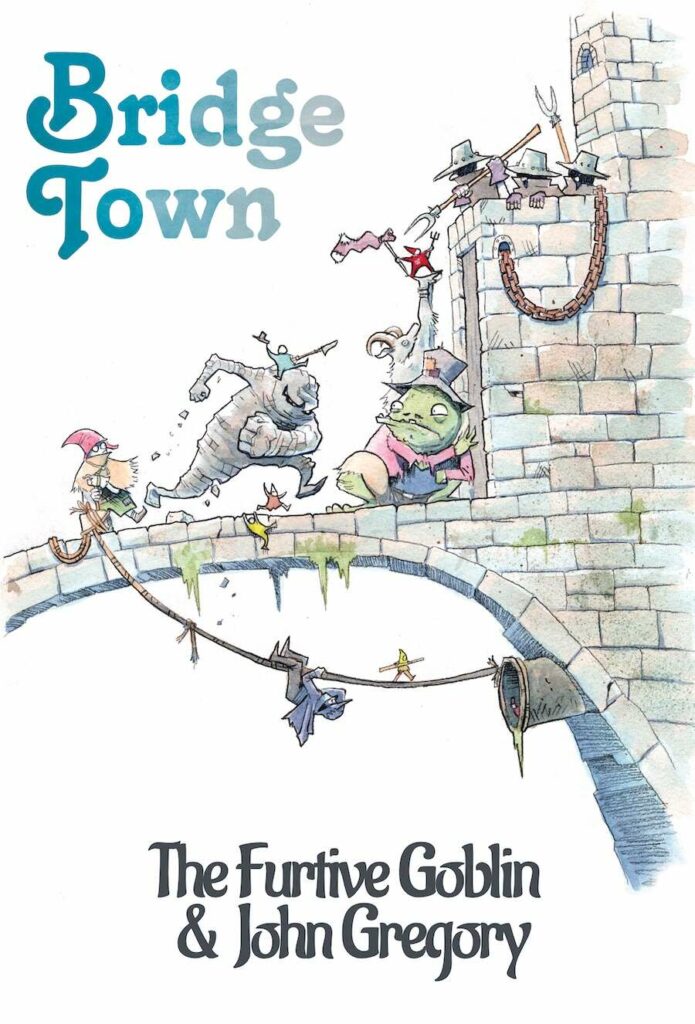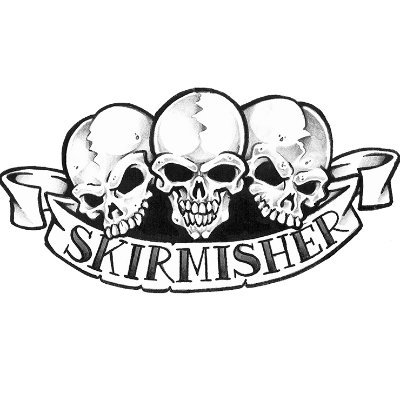Tag Archives: interview
Creator Spotlight | An Interview with Hankerin Ferinale of Runehammer about Crown and Skull


Fantasy RPGs are a dime a dozen, but Crown and Skull promises a refreshing experience. In this interview with Hankerin Ferinale, creator of the system from Runehammer, we delve into the unique mechanics, world-building, and design philosophy that sets Crown and Skull apart.
Ferinale sheds light on the inspiration behind the game, how it challenges player interaction with the world, and the exciting future planned for this evolving system. So, grab your dice, and prepare to be enthralled by the evocative world of The North Holds!

Crown and Skull feels like a fresh take on fantasy RPGs. What inspired you to create this unique system?
I played Fantasy Hero (1st Edition) for years in high school. The system didn’t age terribly well, but its foundational thinking was great. After 8 years of RPG publishing, I wanted to both look back to my origins and forward to a few current inspirations like Cairn and Into the Odd. That’s just the mechanics. The WORLD and TONE are where I’m the most excited. I’ve been working as a writer and artist for over three decades now, and I started to feel real, emotional, moody, evocative stirrings in this setting. I hope all the readers feel as deeply connected to THE NORTH HOLDS as I do. That humanist connection is teh core inspiration of the book(s).
The “skill as tool” approach sounds intriguing. Can you elaborate on how this changes player character interaction with the world?
For ages now, we’ve been taught that our stats/attributes can solve any problem with a die roll in role playing. Removing stats from the mechanics and being strict above the use of skills only, forbidding attempts by the unskilled altogether, is the biggest step toward substantive character differentiation I have seen. So different, in fact, I find many players and GMs a bit dazed at first, then very excited. As for interaction with the world, there’s far more think-before-act. The player can’t simply roll a stat to get out of a bind or overcome a challenge.
The phase-based combat seems like a strategic twist. How did you develop this system and what are its advantages for players and GMs?
I didn’t! I reduced Fantasy Hero’s 12-phase system into a 5 phase setup. The advantage is almost entirely offered to the GM. These 5 phases allow room to build truly challenging foes against even large parties of heroes. A single foe might take action(s) on up to 3 phases, while heroes are always limited to one. This lets the monsters expand into vastly larger realms of challenge and variety, compared to traditional initiative systems.

Crown and Skull is known for its emphasis on player skill over character stats. Can you talk about the design philosophy behind this approach?
As mentioned above, stats blend all characters together. By removing them entirely, and forbidding attempts by the unskilled, the differences between heroes becomes extreme. MUSCLE is a skill, not a stat. No muscle skill? You can;t even ATTEMPT to move the boulder. This differentiation enhances one of the key visions of the hobby’s framers: that characters need each other to thrive.
We’ve seen some discussions about the lack of traditional “gold” mechanics. How does Crown and Skull handle character progression and rewards?
In CROWN, you earn hero points. Gold is seen as banal and uninteresting, though present if your table wishes. Hero points replace gold, and adjudicate the finding of usable loot. They come in all kinds of reard packages, from deeds of renown, to the dire and unavoidable choice of THE CROWN, OR THE SKULL?

Crown and Skull is still evolving. What are some exciting things you have planned for the future of the system?
There are 4 more volumes of CROWN and SKULL coming. These volumes introduce new mechanics, world material, and tables. The coolest part of the forthcoming volumes, though, is portraying ongoing epochs of the world, influenced and shaped by the actions of all of CROWN’s players and GMs. It is a 6 year experiment in a truly living world… another core dream of our hobby’s mighty originators. Achieving a truly living world is not easy! It requires a DAILY interaction habit with the player community.
Do you have any advice for GMs and players who are new to Crown and Skull?
Join the Runehammer Discord! This isn’t a sales pitch at all, but a call to engage with a living, breathing community that is building a world brick by brick. It’s also a great resource for those odd questions or sticking points as many 5E players seek new horizons.
Thanks for the interview, Obsidian! FOR THE CROWN!
-Hankerin Ferinale

Crown and Skull is produced and published by Runehammer. Visit them on social media:
Patreon, Youtube, Instagram, X (formerly Twitter), Facebook
Creator Spotlight | An Interview with the Creators of Divination RPG
Divination RPG offers a transformative approach to tabletop roleplaying, merging the ancient tradition of tarot with the dynamic mechanics of RPGs. This game invites players to embark on a journey of self-discovery and adventure, navigating a world where the flip of a card determines fate.
In this exciting interview, we delve into the minds of the creators behind this innovative game, Matthew Muñiz and Nyx Tesseract, to uncover the inspiration, mechanics, and future for Divination RPG. Join us as we explore the fascinating world where destiny is woven with each card drawn, and where players become active participants in an unfolding narrative guided by the very tools of divination.
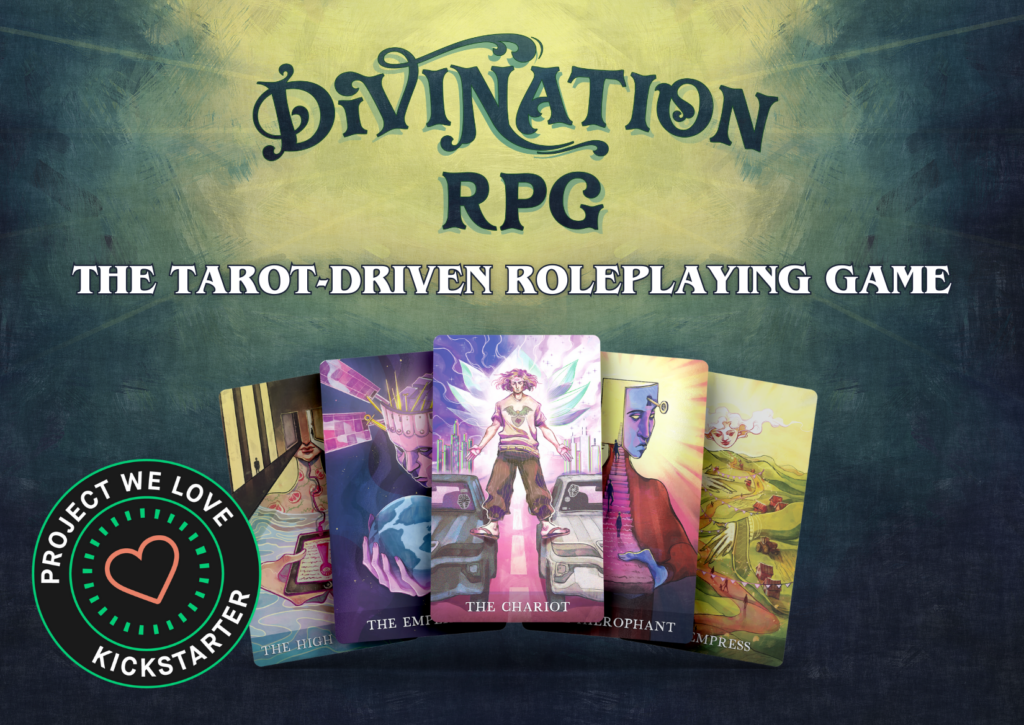
Don’t just consult the cards, adventurers! Support the Divination RPG Kickstarter!
What initially drew you to incorporating tarot into an RPG experience?
I’ve always used tarot as a part of my TTRPG ventures, I think. It’s been an idea generator, a generator for NPC motivations—a set of huge, abstract symbols from which to draw. So as I ran D&D games growing up, and later, World of Darkness games, I liked to use tarot to get ideas about plots, motivations, antagonists, worlds of magic, all kinds of stuff. I got my first Pixie (RWS) deck in my teenage years, and started running games for my friends right around the same time.
Matthew Muñiz
Were there influences other than tarot that served as inspiration for the game’s mechanics?
I loved the World of Darkness games from the 90s, and grew up on Basic and Advanced D&D—a childhood inheritance from my erstwhile-nerd parents. I liked how WoD games let you develop your character without levels (I recall that as revolutionary once upon a time, way back when). Those worlds also aspired to delve into the psychology involved in role-playing and character development. I think of those games as blazing a trail that now lots of other narrative-first games follow.
Some of those, like Bluebeard’s Bride and Kids on Bikes, use shared hero and shared character dynamics that really influenced Divination as well. As roleplaying games explore GM-lessness, elements of shared storytelling are becoming increasingly common, and I think those mechanics work beautifully in Divination because it’s based on tarot. Tarot is so much about introspection and personal growth, and so a game where the parts of the mind negotiate that (and sometimes fight over it) suits our world really well.
Matthew Muñiz

Can you walk us through the core mechanics of Divination RPG?
There are two main mechanics that make up the heart and soul of playing Divination. One is the shared Hero that Matthew mentioned, and the second is the performance of Tests.
You play Divination as one Aspect of a Hero, and your fellow players are also Aspects of that same Hero. Each Aspect embodies one set of drives and desires inside that person, which adds an additional element to roleplay. Sometimes one Aspect is in Control of the Hero and is navigating the world and dealing with NPCs just like any other roleplaying game, but at other times we zoom in to the internal and see the conversations happening between the Aspects—the Hero’s internal thoughts and conflicts and questions playing out live. Each player has an Aspect sheet which tracks the stats and abilities unique to them as an individual, and collectively the players share a Hero sheet which tracks the stats available equally to all of them.
Where all those different stats and abilities come in brings us to the other core mechanic of Divination: the Test. This is essentially your skill check, but it’s resolved by drawing a tarot card instead of rolling a d20. We use one portion of the tarot deck that contains numbered cards only, and draw a card to get a numerical result (after applying modifiers to reflect difficulty, stats, and Powers, of course). The number gives a clear success or failure, but the scene depicted on the card and the meaning of the card is rolled into the how of that success or failure as well.
Tests can be Active when the Hero is proactively acting on the world, or Passive when they need to respond to the forces of the world acting upon them.
Nyx Tesseract
How do you envision the concepts in Divination RPG fitting into the broader world of tabletop RPGs?
One of the things I’m personally most excited about is the way Divination handles the Hero’s experience of being hurt both physically and emotionally. We’ve separated this experience into Injury, which happens to the body, and Harm, which happens to the mind or the psyche. I don’t want to spoil too much of what you can discover playing the game, but I think we offer the opportunity for players to explore a lot of nuance in what it means to be hurt. This is something we’re really excited about offering to the gaming community at large, because I don’t think either of us has seen it handled or delved in quite this way before.
And I mean, it’s so tarot. It’s so tarot to explore every element of our human experience, the good and the bad, through a lens of non-judgmental curiosity.
Nyx Tesseract
How does interpreting the cards impact the gameplay and decision-making process for players?
The beautiful thing about Divination is that it’s both numeric, which means it can do the things that dice can do, and it’s pictorial, which means it speaks in the fuzzy, flexible language of pictures. When a Test is read, it does more than just tell the players whether or not they were successful at whatever they were trying to do—it can also suggest why. This almost always amounts to thoughts and feelings that influence the moment, but a Diviner is invited to weave the meanings they read in the cards into the story in any way that inspires them. This makes for emotional, profound moments where everyone is surprised by what they discover in the cards. I know we keep saying this, but it’s so tarot.
Matthew Muñiz
What challenges did you encounter while designing a system that incorporates both numerical crunch and interpretation of tarot cards?
It’s challenging to offer people permission to interpret tarot cards. People think they have to memorize long lists of meanings, but in my opinion, all you have to do is look at a picture and allow it to make you feel something. In Divination, we divide the tarot deck into smaller decks to make it easy to do this. The mechanical crunch is fairly easy, with +1s and -1s like other games.
You really just have to trust that you’ll look at a picture and seize the opportunity to be creative with what you see—or give yourself permission to skip that part when you want! You don’t have to interpret any moment that doesn’t make sense to you. A joy of Divination is allowing a symbol to persist and coming to understand what it means later.
Matthew Muñiz

Besides tarot’s role in the mechanics, how does tarot exist in the world and society of the game?
Tarot is baked into every part of our setting, which imagines two worlds: the Apparent and the Esoteric. The Apparent is the mundane world we all inhabit, and the Esoteric is the one populated by Artists—modern wizards who use the tarot and their unique connections to the Art to pursue their agendas.
These Artists each walk a Road that dictates what their connection to the Art is like. There are seven Roads in total, and each is wildly different. In Divination, you’ll make a single Hero on a single Road, so you get incredible replayability from our game as you explore all seven Roads. Each Hero on an Esoteric journey will be a part of a rich world full of competing agendas and surprises, all drawn from tarot.
Matthew Muñiz
What has been the community’s response to Divination RPG so far?
We’ve been just blown away by the way Divination seems to really touch every single person that touches it. I think the shared Hero is a huge part of that, and particularly the way the game builds that Hero. Our character creation process isn’t something you do at home before you show up to play; it’s almost a game in and of itself as the players are led through a series of story prompts (guided by tarot cards, of course) to tell formative stories about their Hero’s life. It acts as kind of an icebreaker, but in practice it becomes so much more than that. We run a lot of games at conventions and events where you regularly have four strangers come together for a game, and we’re always blown away by how naturally the game fosters investment and trust as the players build their Hero together. It’s pretty magical.
Nyx Tesseract
Are there any plans for future expansions or other content related to the game?
The core book—the Divination RPG Guidebook as we’re calling it—is going to be really complete in terms of running and playing the game. But as Matthew mentioned earlier, there are these seven different Esoteric Roads to explore, and I think that’s the most likely place for some expansion. The core book will include setting information for each Road, but eventually we’d like to create a full campaign module for each one as well, complete with NPCs, antagonists and threats, and even an outline of story beats and options. Currently we’ve got a full module like that for one of the seven Roads, but that’s a place we’d love to continue exploring and even bringing in outside writers to create more of those modules.
Nyx Tesseract
What is one of the most creative things you’ve seen players or Diviners do with Divination RPG?
I think you could pose this question to our Discord community and get dozens of stories, so I’ll just share one very recent one that brings me so much joy. One of our Discord members ran across an event called “Capybara Week” where a gaming group was looking for GMs to run any system with a capybara theme. Our community member signed up to run a Divination game with the following pitch: “Four aspects of the mind of someone find themselves awakened one day inside the body of a capybara, by a twist of fate. Together, they will navigate this new life on the shores of the lagoon, deciding whether to adapt or seek a way back to who they once were.”
Nyx Tesseract

Obsidian Portal Campaign of the Month February 2024: Cyberpunk 2077 Fate Accelerated
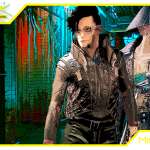
Welcome to a futuristic world where corporations control everything from their skyscraper fortresses, enforcing their rule with armies of Cyborg assassins. Gape in wonder as the player characters track down a Combat Cabb in Dog Town, using cyberenhancement and cutting edge technology in HumAnnoyd’s latest High Tech site, Cyberpunk 2077 Fate Accelerated!
You are no newcomer to this forum, having won several times before. Some people may know you already, but for those who don’t, how would you like to introduce yourself? Anything new going on?
I am an artist, designer and animator who has made a living in video games, tech, education, and marketing. Inspired by Tolkien and Star Wars I started playing RPGs in the late 70s with the Holmes Edition of D&D and ran my first game using Traveller’s “little black books”. In the 80s I picked up Cyberpunk 2013 and ran a seven-year campaign using it and CP2020. This year has been trying due to an intense battle with cancer, but it looks like I am on the mend and may just beat it yet.
What new approaches did you take when designing your site for this new game? Did you adapt old templates or start with an “empty page”?
This website was a little different than my others. During the pandemic I was put on furlough, so I started working on writing rules for a Fate Accelerated version of the video game based on the Dresden Files Accelerated rules. To prevent losing my mind in boredom and to keep my design skills sharp I decided to lay it out in InDesign, using an aesthetic inspired by the amazing artists of the video game. I built the OP Site after that, trying to recreate that aesthetic online.
Are your players new, or have you stuck with players who have been with you in previous games? How often do you play? What are your sessions like?
My roommate and his cousin both expressed interest in playing CP2077A and have little experience with RPGs and none with Cyberpunk. We have played the first two sessions in person but, due to busy schedules will be using Discord and Roll20 going forward.
The sessions have been quite fun so far, with both of my players being creative and clever. I cannot wait to see how the campaign develops as they gain more confidence and experience! We also have a couple of people who may join the game soon.
You are obviously a big fan of the Fate Accelerated Game. What do you like most about it, and in what ways does Cyberpunk 2077 differ from Emerald City: Requiem, which won Campaign of the Year in 2022?
I think the primary difference is that DFA is a full game with rules out of the box. I had to write and create rules for the CP2077A game which required a lot of picking and choosing from Fate’s vast tool sets and games as well as innovating my own ideas. The Emerald City is also set in a city that the players all participated in creating while Cyberpunk is the creation of Mike Pondsmith and the amazing team at CD Projekt Red. What I love about Fate Accelerated is that is such an easy system to hack and for new players to grasp. It also gives players agency to flourish narratively and with much more freedom compared to many other RPGs.
Your choice of artwork throughout the site is great, but it looks like you manipulate each image to give it your own particular flavour. Can you share how you go about this, and what sort of tools you use in your “touch up” palette.
The images are all taken from a mix of screenshots from the video game and photographs blended in a long and involved process in Photoshop that I have been honing for over a decade now. I use an arcane mix of smart objects, filters, actions, blending modes, layer styles with some painting for the final touches that results in massive file sizes of 3 Gigs or more. I am constantly changing and adapting my process as I learn new things.
Tell us a bit about the Cyberpunk world. Boostergangs, techies, outriders, Maelstrom gangers, roadwarriors! How do your cyberenhanced players interact with these characters? Where are they heading?
My players are involved with the 6th Street Gang whose leader just died under mysterious circumstances. The heir apparent of the gang asked them to quietly track down one of his missing friends who went missing along with his expensive Combat Cabb™ in Dog Town, the walled-off combat zone on the edge of Night City that is run like a fiefdom by an ex-soldier who betrayed his masters. The PCs have managed to use some impressive cybernetic implants to infiltrate a business and track down the Cab’s GPS signal to a garage held by the hated Scavs gang. I cannot wait to see how they will carry out the contract and the repercussions that will arise from their actions.
Do you get help from your players in adding to the site content? Or do you do most of the “heavy lifting”?
For now, I am doing all the writing and art and creating for the game. I am hoping that, as my players become more adept at the game, they will help with that “burden”.
You have obviously been with Obsidian Portal for some years. In recent years, many gaming platforms have come onto the scene. What keeps you “sticking with” Obsidian Portal.
I love Obsidian Portal’s ease of use and adaptability with CSS. I am constantly pushing myself to do something new and better with my sites and OP has always risen to that challenge for me. I also enjoy the community who are all a great help when I run into a snag with CSS or provide feedback on a design choice.
If you had to pick just one thing, what would you say Obsidian Portal helps you with the most?
Organization. Having written my own rules for this game OP has proved invaluable for keeping them organized and easy to access for my players. As the game develops there will be more and more NPCs to track and that is so easy using OP.
What would you say is the biggest highlight of your new game so far (please also provide images and links if possible)?
I think the best part of the game so far is when my players started realizing how much freedom they had in the game. They were wanting to infiltrate the Combat Cabb™ garage and came up with a good plan to do so with little to no prompting from me. The infiltrator had to improvise and role-play a fair amount to make it all work and my players did so despite having had little experience with RPGs in the past.
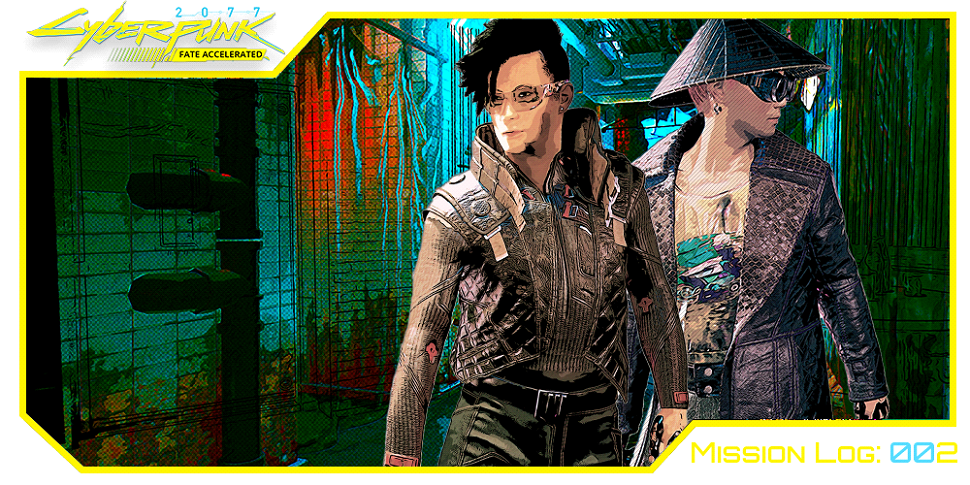
Okay, as a last question, we always ask for the GM’s “pearls of wisdom”. What GM insights can you offer the community this month?
I strive to always stay flexible enough to be able to react nimbly to my players’ choices and plans while at the same time providing enough narrative structure to keep the story interesting and fun for us all. It is a very delicate balance that benefits from trying to never say “no” to my players. This gives the players a greater sense of ownership of the game and agency to be truly creative. I admit that I sometimes struggle with it when I get too attached to certain ideas or storylines, but it is always my goal.
END
Creator Spotlight | An Interview with The Furtive Goblin and The Lawful Neutral (Bridgetown)
In the realm of tabletop roleplaying games, few settings capture the unique blend of pastoral charm and liminal unease as effectively as Bridgetown from Technical Grimoire. This never-ending, ever-crumbling bridge straddling the boundaries between realms has become a popular destination for adventurers seeking a taste of the extraordinary.
Behind the imaginative tapestry of Bridgetown lies a team of creative minds who have poured their passion and expertise into crafting this enchanting world. We had the privilege of interviewing the Lead Writers of Bridgetown – The Furtive Goblin and The Lawful Neutral (John Gregory) – to delve into their inspirations, design philosophies, and hopes for the future of Bridgetown.
In this interview, we’ll explore the genesis of Bridgetown, the unique challenges of designing a setting that defies conventional boundaries, and the team’s vision for the game’s future. Prepare to embark on a journey through the ever-shifting landscapes of Bridgetown, where the ordinary meets the extraordinary, and the boundaries between worlds are as fluid as the river that flows beneath the ever-present bridge.
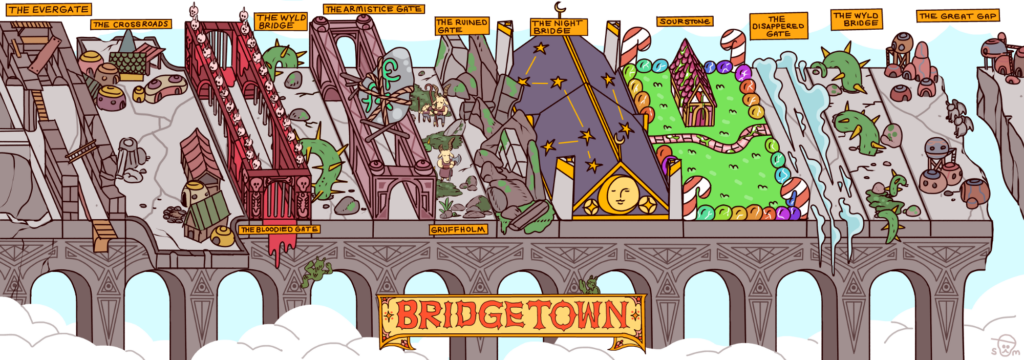
What makes Bridgetown different from other TTRPGs?
Bridgetown is a campaign setting for Troika! which seeks to exchange its default gonzo science-fantasy flavor for something different. It’s a game set in an impossible location–a never-ending Bridge–that is caught somewhere in between rustic folklore, Boschian fever dream, and dystopian punk, with a little sprinkle of hobo culture for good measure.
The Furtive Goblin
Bridgetown is a setting and resource book that goes along with the very inspiring Troika! system, which itself was inspired by old school Fighting Fantasy. Troika! overall has done an amazing job at inspiring weird and psychedelic settings that range from science-fantasy to cottagecore to genres I’ve not even got a name for. Bridgetown itself is what we’re calling a Liminal Pastoral setting–somewhere between wandering across Ghibli landscapes, living on Old London Bridge, and being stuck in The Backrooms. It is a weird world caught between infinities on every side, yet it is homey.
The Lawful Neutral
What are some of the challenges you faced while designing Bridgetown?
We (TLN and I) had a lot of ideas to start off. We spent almost an entire week just doing an idea jam while looking up images of old medieval bridges. Way too many ideas to fit into a single product and still get away with calling it a zine. We had to hone our focus to be more narrow and bridge-like. Fortunately, our team was way better at making us do that than we were at first.
The Furtive Goblin
Really, once Furtive Goblin and I got onto the Bridgetown writing train, the main challenge was knowing when to stop. We came to David/Technical Grimoire with pages and pages of ideas for what was originally going to be a little twenty page zine. With the help of David giving us reasonable restrictions and Hannah, our editor, taming our writing, we were able to go from a complete mess of materials to an actual functional Bridge(town.) That all said, another part that we considered a design challenge was “How do we make a setting interesting that is literally only 50 people wide East/West and infinite North/South?” We thought that it could feel constricting or railroad-y, but our playtesters really felt like the space restrictions actually made for interesting challenges and gave them a good impetus for continuing to journey onward.
The Lawful Neutral
How did you playtest Bridgetown?
TLN and I took a hands-off approach to playtesting, and let David run several games with playtesters that he organized. This ensured there was little to no influence from us as the writers on how the players interpreted the text. It also led David to make some really fun and interesting calls as a referee that helped shape how the rest of Bridgetown was written, alongside all the player feedback we received.
The Furtive Goblin
Our playtesting was done by a combination of several very fun sessions run by David as well as a pair of live plays on Twitch! Instead of personally running or playing in it ourselves, Furtive Goblin and I listened in on the sessions and paid attention to what did and didn’t work, what folks were excited about, and where we could tweak parts to be more clear. One of the major changes to come out of it was the original fundamental premise. We had planned for folks to be playing a character that is ultimately looking for a place to settle down and make their Home, allowing the character to retire and someone new from the location to adventure from there. However our playtesters had so much fun with their initial characters that they simply wished to keep on journeying!
The Lawful Neutral
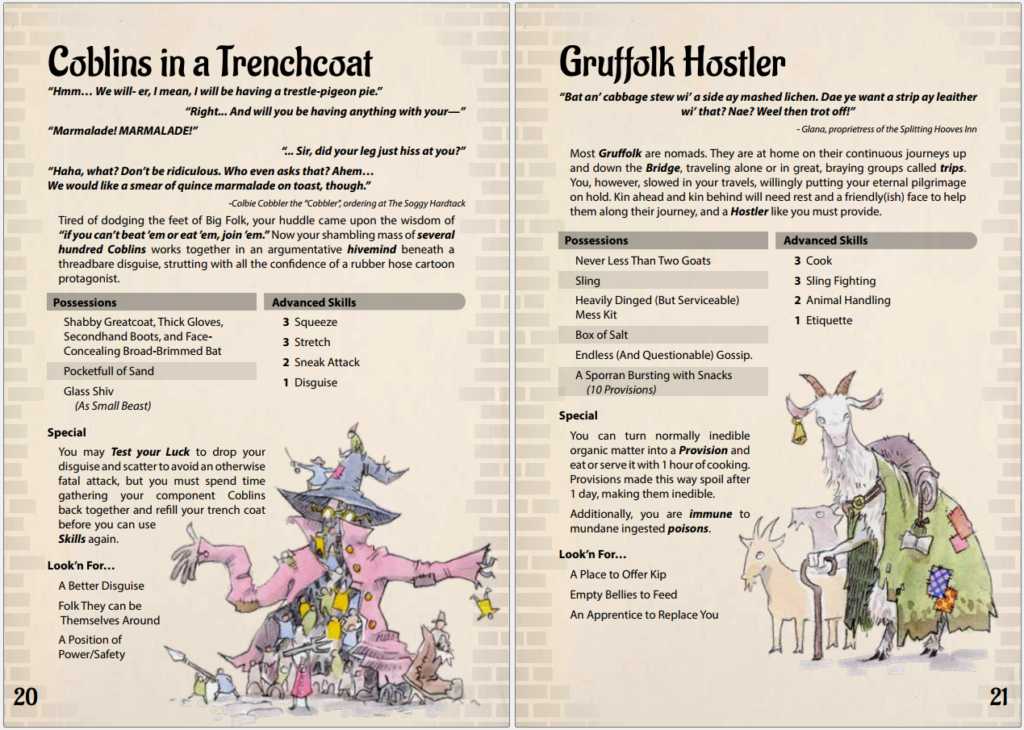
What are some of your favorite features of Bridgetown?
The “Weather” table including flocks of awful birds dropping feces like a hailstorm is definitely a crowning achievement of Bridgetown, and gaming in general. In seriousness though, I love that we managed to build a sort of natural ecology into the Bridge, with all the critters and weirdos that entails. The book has some of my favorite backgrounds in all of Troika! Ghost hivemind golems (Stone Keenings) and Brummie-accented sewer trolls are pretty high up there.
The Furtive Goblin
The certainly colorful locations and NPCs, many of whom are inspired by our own personal game experiences. Each span and district of the Bridge has its own unique flavor which we hope is inspiring to anyone who decides to walk it. You could take pretty much any setting or genre, mix it with a little weird, and set it down onto the Bridge. And if you ever get tired of it, all you have to do is jump off the side and see what strange new world you land in!
The Lawful Neutral
What are your hopes for the future of Bridgetown?
I can realistically see us working on Bridgetown for a few more years, whether it’s in the form of adventures or fun new ideas for backgrounds and locations. One early idea we put on hold was designing a Bridge generator that you can use to create randomized districts filled with events, landmarks, etc. on the fly. We went with individually crafted locations instead, and I think that was vital to nailing the themes and atmosphere of Bridgetown. But I still think that generator would be the perfect capstone for the IP, as a way of giving it over to the players once we’ve said our piece. As endless as the Bridge is, I don’t think we’ll be churning out endless amounts of content. It needs to be allowed to breathe.
The Furtive Goblin
Furtive Goblin and I are still writing more and more for it and we think it would be great fun to have expansion zines come out for it over time. I’d personally love to hear from folks about any sessions they run and how they put their own unique spins on it. One of the ideas we were not able to fit fully into the book but we encourage people to consider– each of the infinitely tall Piles/Pillars that the Bridge sits on could be hollowed out to throw any dungeon you might want in there. We might get out something in the near future giving some fun examples for this.
The Lawful Neutral
Can you talk about the pastoral and liminal aspects of Bridgetown?
“Pastoral” as a concept is a huge beast that encompasses thousands of years of literature, poetry, and music, but for Bridgetown we used it in the sense of the idealization of the rustic and the rural; the shepherd wandering with their flock. It kind of takes a sarcastic or ironic bent here, because the Bridge is anything but cozy and rural. It is literally liminal, in that a bridge is a thing meant to connect two locations that don’t exist in this scenario. But it’s also liminal in the sense of a lack of belonging. It’s a game of punks and wanderers looking for something that their tiny sliver of infinity didn’t provide them.
The Furtive Goblin
Take the story of the Billy Goats Gruff. On one side there are the barren hills from which our three Goats come from and on the other are the heavenly Fat Pastures that they wish to reach. In between there is a bridge and a troll. This is an idealized pastoral landscape that the Billy Goats live in, but the story takes place on a bridge–a liminal place that is neither here nor there, it is the place in between here and there. In Bridgetown, the Bridge is all there is. The Bridge and the promise of the Fat Pastures. It is where the hope of a rural but uncomplicate life is shadowed by this strange, unforgiving landscape where people of all walks survive the best they can. There is probably some sort of allegory for Purgatory in there if someone wanted to run with that.
The Lawful Neutral
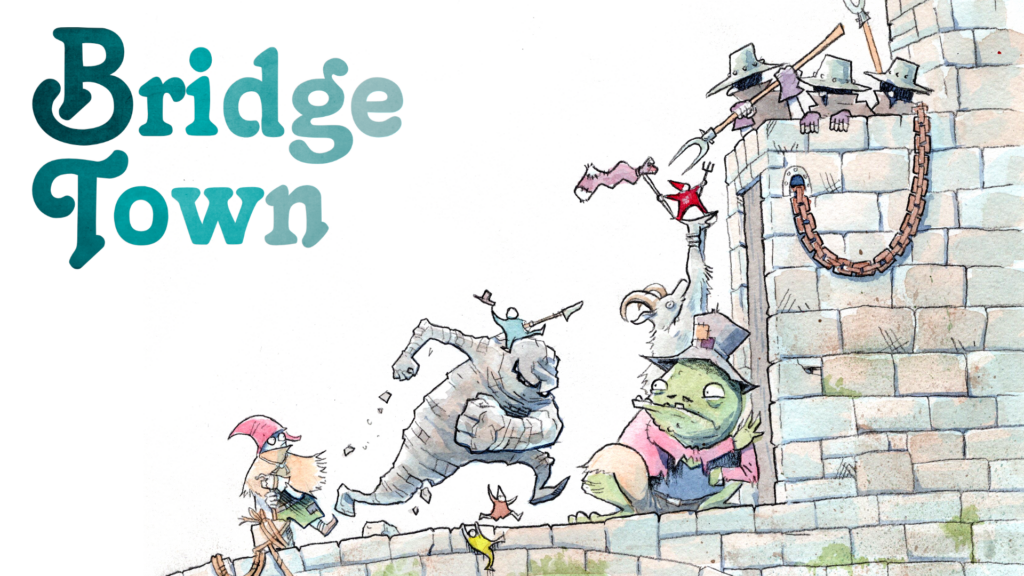
How does the provisions-based economy work in Bridgetown?
Food-as-money is one of many ways business can be conducted on the Bridge. Commerce inside a neighborhood is as simple as hashing out agreements and giving gifts between people you’ve known your whole life, but anywhere else on the Bridge you’re a stranger whose word is only as good as the goods and skills you possess. And no matter where you go, everybody needs to eat (except maybe Stone Keenings). So provisions are an obvious and practical medium for trade, with the added bonus of not having to deal with turnpike guilds.
The Furtive Goblin
When your world has a 50-man wide boundary, you have to make due as much as possible with the space and resources you have for there is scarcity everywhere. The Tower Aristocrats and the Turnpike Guild try to impose local currencies–but these are more or less like the script that mining companies imposed, useless outside of their immediately controlled areas. And so the name of inter-district trade is all about bartering. Iron from the Cable Mines traded for produce from The Squeeze, artifacts pulled up from The Great Excavation traded for clean water sourced from the Wyld Bridge. Among the motley folks who call the Bridge home, needs often outweigh wants so a loaf of good gitless bread can get you a long way.
The Lawful Neutral
What are some examples of Keystone Spells and Troll-Croak magic?
The magic wielded by Stonewrights–basically stonemason wizards–pulls latent energy out of the Bridge and the stone that constitutes it. Thus they require magical keystones to power their spells. Do this too recklessly, and the Bridge begins to erode and fall apart around you. A perfect example of this is Stone to Soil, which turns rock into dirt- ideally for gardening, but nefarious uses exist too. Troll magic comes from the gut, so to speak. Their spells cost Stamina like in classic Troika!, and reflect the ancient shamanic traditions of the sewer trolls. An example is Inoculate, which renders someone immune to a single disease- handy to have when you spend so much time in sewer water.
The Furtive Goblin
So the biggest differences between the two types of magic here is who uses it. Stonewrights are, by and large, humans who use the energy of the Bridge itself to cast their magics–they bend and manipulate the natural forces of the bridge to their whims. This is why some are Bolsterers, who work to maintain a balance and preserve the Bridge, and some are Eroders, who siphon magic from the Bridge without thought of consequence. When a human dies, their soul is often interred into Keystones to preserve the magical energy of the Bridge itself. A very basic Stonewright spell is Word on the Street, where they essentially commune with the Bridge itself for the local gossip. Trolls, on the other hand, are connected body and soul to the Bridge without the need of Keystones–when they pass away they turn back to the stone from which they were born. Thus, their magic comes from within, allowing their croaking songs channel the Bridge through them directly. A very direct example is Yaulp, which takes the echoing nature of the Bridge’s sewers and amplifies it into a concussive shout that can be heard a mile away.
The Lawful Neutral
What are some of the weirdest birds and weather events in Bridgetown?
Scrapper Herons are four-eyed nightmares with serrated beaks that can rip through metal. You don’t want to be well-armed when one of those starts building a nest. You can’t get much weirder than Under-Things on the Bridge. The Under is a soup of cloudy, rarified reality that the Bridge sits on top of, and once in a while it belches forth Things made out of roiling matter and concept. They’re childlike and curious about the Bridge, which is bad news when their mere presence can kill you or drive you batty. My favorite is the Slavering Under-Thing that understands through taste, and leaves a lot of scandalized Bridgers in its wake.
The Furtive Goblin
My favorite bird is Bosch’s Echo-Babbler, a massive bird hiding in its thick shell and using it to crush unwary targets then slurp them up with an elephantine hummingbird tongue–but that’s the beauty of the Awful Birds. Look at some Bosch or some Zdzisław Beksiński then combine it with a bird and you’ve got yourself an Awful Bird for any scenario. The Weather on the Bridge is more like “Whether” whether we’re going to have rain or a few hundred mouse-sized Coblins paragliding down to stab and steal. While the table of Spells run amok is really absolutely fun, my personal favorite Weather is this: “Scent of Home: A wind blows, carrying with it a smell somehow both unfamiliar and nostalgic, a sweet promise of new beginnings and old dreams fulfilled. A wind like this blew the day you left home.”
The Lawful Neutral

Can you tell us more about the Stone Soup Campaign?
Despite being an introductory quest, Stone Soup was one of the last things we added during development. It’s more TLN’s baby than mine, which makes sense since he’s already worked on at least one other food RPG, Gourmet Street. Stone Soup is essentially a road trip where your map is a list of esoteric recipes and abstract ingredients for the bizarre stuff you can cook up using this totally-not-horribly-cursed cauldron with a magical keystone embedded in it.
The Furtive Goblin
Stone soup arose out of a need to tie everything together and give folks a sort of impetus for travel if they didn’t already have one. There is nothing like giving folks a powerful, strange, non-completely-understood magical item from day one and telling them to run with it. It also encourages folks to look around at everything they encounter in Bridgetown, consider what might be an ingredient, what might hold deeper metaphysical meaning/power. A major inspiration for what counted as ingredients in Stone Soup came from Gleipnir, the rope that binds Fenrir. The Breath of Fish, the sound of a Cat’s footfall, the roots of mountains etc.So those mushrooms that the Troll Sewer Working is carrying is an ingredient, but so too could be the secret name of the Undercrone or the passed along memory of the taste of the Candy-Cobbled Streets.
The Lawful Neutral
What do you think makes Bridgetown a good TTRPG for one-shots?
The Bridge is divided up into locations and gatehouses that each offer a unique feel and plenty of fuel for referees. You could blow through a whole town or a dungeon in a single session this way, if you want them to be bit-sized. You can also build the Bridge “tall” and put way more emphasis on a single place for multiple sessions. Or you could get so absorbed in a single event or NPC that that spirals out into an unexpected emergent story that then dominates the entire session, as our playtesters managed to do a few times!
The Furtive Goblin
Bridgetown is not only great for one shots because our awesome publisher literally made a free One Shot generating resource on his website, but the very distinctive flavor of each district makes it very easy to move from set piece to set piece without significant travel times or lead up normally involved in a large campaign. In the playtests we were generally able to get through three to four districts in a single session–but at the same time there is enough happening in each district that one could spend multiple sessions in a single one if the referee and the players feel so inclined.
The Lawful Neutral
What advice would you give to someone who is new to Bridgetown?
Embrace that feeling of being a drifter who rolls into town and shakes everything up a little. Give yourself over to whimsy, and see where your feet wind up taking you. It’s an endless world out there, and one place is just as good as the next.
The Furtive Goblin
Have fun with it and go with the flow. Bridgetown isn’t necessarily about a specific victory condition, it isn’t necessarily about defeating monsters or gaining treasure. Bridgetown is about enjoying the journey and living the world, it is about trolls who want fair working conditions and nomadic goatfolk for whom life is an eternal pilgrimage. It is about tiny boschian goblin-things who alternately want to stab big folks and live comfortably inside their walls. It is about being a ten foot tall rock monster who wants, more than anything else, to find a place to truly rest. In short, it is the same advice I’d give to any player–play the world.
The Lawful Neutral
What’s the most creative thing you’ve seen a player or GM do with Bridgetown?
Early on in the playtest, our Stone Keening character effectively no-selled a potentially very hairy encounter by absorbing an angry, out-of-control magical experiment into itself, giving the spirits the experiment was made out of a chance to cool down in a safe space. It also had the side benefit of righteously pissing off the mad doctor who was behind it.
The Furtive Goblin
In one of my favorite playtests a group of Coblins and a Stone Keening worked together to bind, rejuvenate and give a sort of metaphysical birth to long lost souls using their combined connections with the Bridge and interactions with a particular strange stone you’ll find in Craterton. But that is only one of a dozen such stories I could tell about how we’ve seen players take our basic prompts and turn them into so so much more.
The Lawful Neutral
What might fans look forward to in the future from you?
More Bridgetown! It might take a while to get a sequel/extension book squared away, but the team plans to have another Bridgetown book out sometime next year. We left way too many neat ideas on the cutting room floor not to. As for me personally, I am mostly focusing on my blog and the occasional book contribution or playtest.
The Furtive Goblin
I am right now between books so I’m largely self producing mini generator zines for folks to have fun with. Magical Miscreants, a Witch/Wizard generator, and Gobs Galore, a goblin generator, are my latest ones on Itch. However, Furtive Goblin and I hope to produce more Bridgetown content with Technical Grimore in 2024 as well as getting our greedy writing fingers into some more projects. Keep an eye out!
The Lawful Neutral
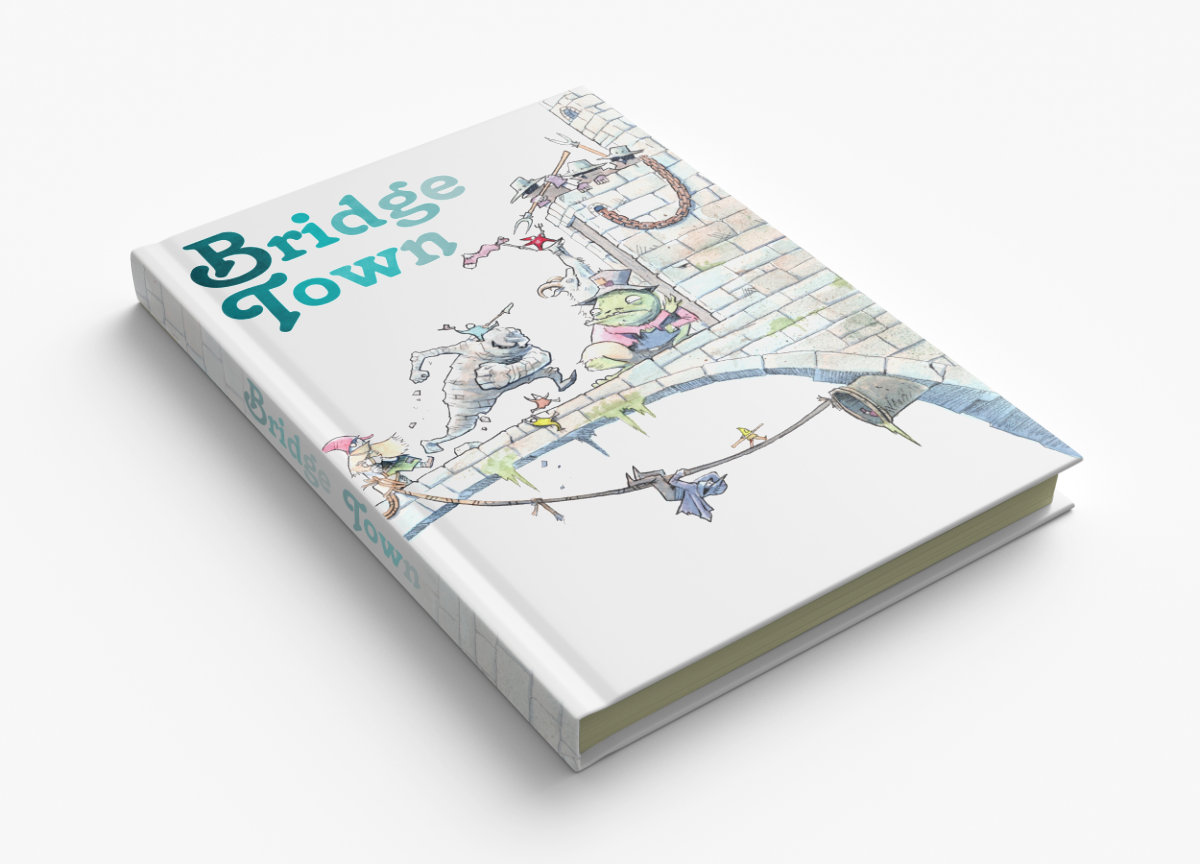
You can find more about Technical Grimoire on their website, Twitter, Facebook, Instagram, or Discord. The Furtive Goblin and The Lawful Neutral can both be found on Twitter.
Creator Spotlight | An Interview with Brenda Cass of Skirmisher Publishing
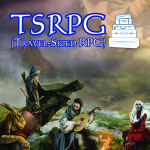
In a world where gamers are always on the go, TSRPG (Travel-Sized RPG) is the perfect game for those who want to enjoy a roleplaying experience without having to lug around a heavy rulebook or dice. Created by Brenda Cass of Skirmisher Publishing, TSRPG is a lightweight game that can be played anywhere, with just a few simple rules.
In this blog post, we interview Brenda Cass to learn more about TSRPG and her inspiration for creating it.
What inspired you to create TSRPG?
The very first draft of TSRPG was written, I think fittingly, on a hotel notepad while I was on vacation with some gamer friends. We ended up with plenty of downtime between activities that we’d normally occupy with gaming but, not having brought any of our usual tabletop stuff (dice, rules, characters, etc), that seemed unavailable to us. At the time I was participating in somewhat regular game-design challenges on d-Infinity.net, so I told my friends I’d design a game that could be played without any of that stuff. It began as a thought experiment and a fun little challenge but ended up working super well in play.
What are the key features of TSRPG that make it a travel-sized RPG?
The game’s original design constraints were that all the rules had to easily fit in your head, there couldn’t be any book keeping, and it couldn’t require any physical randomizers like dice, etc. As a consequence of those constraints TSRPG has simple mechanics that are solely concerned with creating and moving along a shared narrative. Character sheets, such that even they need to exist at all in TSRPG, fit onto a cocktail napkin, hotel notepad, or whatever small piece of paper is at hand. Randomizing outcomes involves guessing numbers, and most importantly the Storyteller has no stat blocks, hit points, ability points, or what have you to keep track of; their only job is facilitating the narrative and helping make sure everyone’s having a good time.
How does TSRPG differ from other tabletop RPGs?
TSRPG differs from other tabletop RPGs in a few ways. It is a high-trust, rules-light system, which makes it feel very different from a lot of the crunchy RPGs out there. It’s diceless, which is definitely a less common feature (don’t worry dice fans, there are optional rules for using them). TSRPG puts a lot of emphasis on crafting a shared narrative with other players in the pursuit of overcoming the story’s challenges as a party, which is a bit different from the mode many folks are used to that involves selecting one of their character’s abilities when their turn comes around in the initiative order.
What are some of the challenges of designing a game that can be played anywhere?
I have to assume that people playing TSRPG are going to be just as resource constrained as I was when I wrote the draft and played it for the first time. For a lot of designers the reflex with RPG design is to have a kind of “more is more” sort of mindset, but for a game like this any mechanic we add potentially puts it over the edge into something that can’t be played on the go. I’ve encouraged folks in the Skirmisher Game Development Group to go play TSRPG with family, friends, or strangers while they’re out traveling. This informed a lot of design decisions that we never had to consider before, PDFs of scenarios are probably being viewed on a cell phone rather than a laptop, new rules need to be highly modular so that they can be selectively added or ignored depending on how many rules folks are up for keeping in their heads, scenarios are more likely to be interrupted so encounters need to be easy to pick up and put down. We find ourselves having to adjust and adapt a lot of what we’ve been doing because TSRPG is so different from anything we’ve done before.
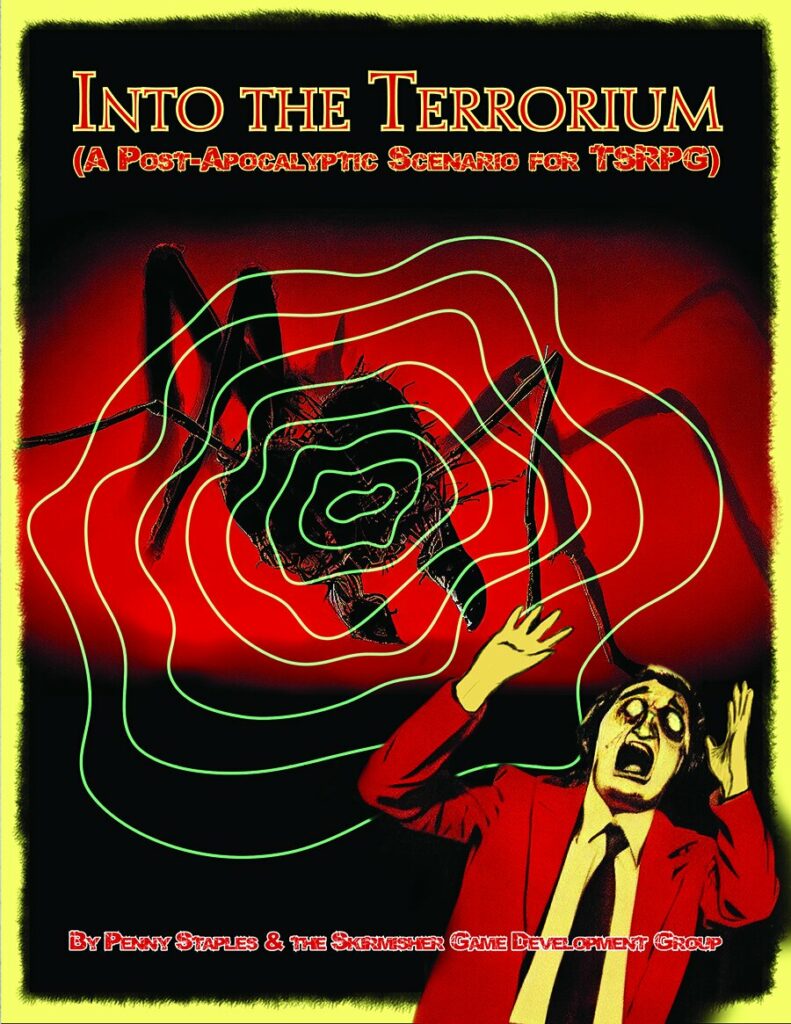
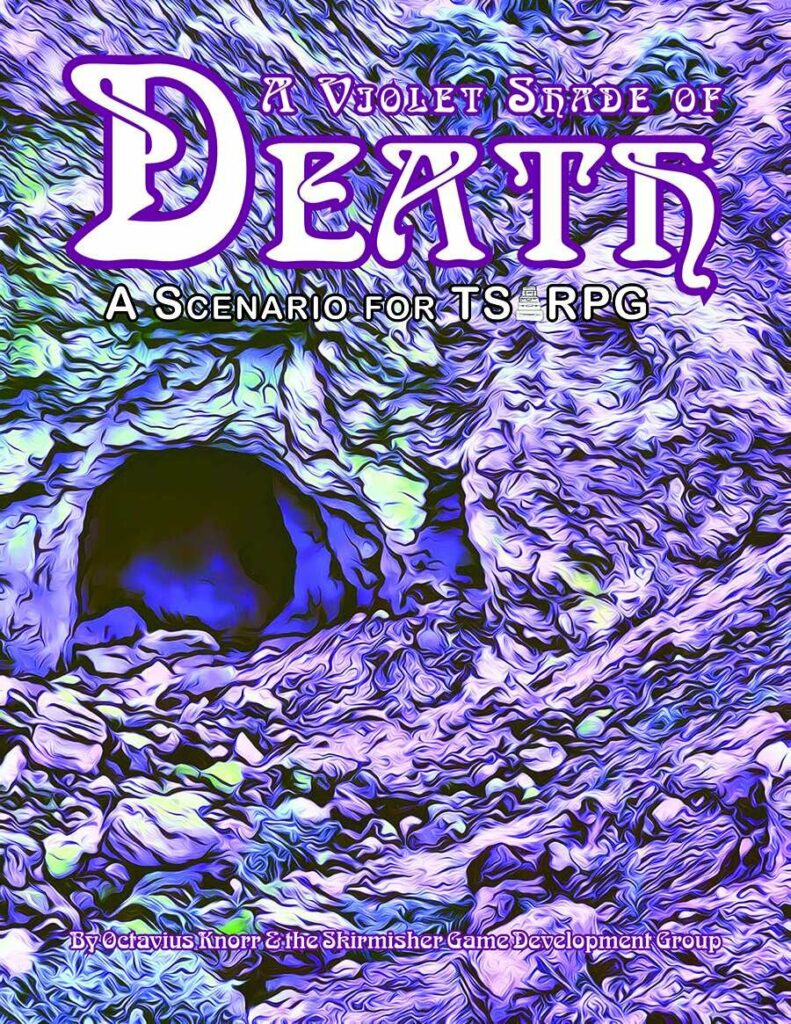

How have you seen TSRPG be used in different settings?
The nice thing about TSRPG being a rules-light system is that you don’t run into any mechanical conflicts with different settings. I’ve seen it used for post-apocalyptic, fantasy, sci-fi, modern day, fairytale, horror, you name it, and there’s already scenarios published for most of those genres.
What are your plans for the future of TSRPG?
The big plan right now is a self-standing game, with its own unique setting, that uses an adapted version of TSRPG that we’re calling “Aesopia”. Aesopia will feature animal people and lean toward humor, quirkiness, and absurdism; it’s the sort of game we wouldn’t want to pair with a more mechanics heavy system. It will have everything folks need to run their own scenarios in that setting and also several supporting scenarios written by us. Skirmisher also recently published a kind of “conversion kit” for playing old school adventure modules using TSRPG called “OS-TSRPG”. It makes it so you can bring your favorite module along with you in a suitcase or backpack and play it on the go with little to no prep. I’m excited to see similar tools for scenarios designed for other systems.
What advice would you give to someone who is interested in trying TSRPG?
Watch one of the samples of play on Youtube, then pick out one of the pre-written scenarios that sounds the most fun to you and give it a try. They’re cheap, they all have a copy of the core rules in them, and any scenario specific mechanics are called out inline. The core rules all fit on one page so learning them isn’t a big time commitment. I’d also say that because TSRPG is a high-trust game, don’t play with jerks because they can really ruin the experience, but I’d also give that advice for playing any other game.
What are some of the challenges of running TSRPG for a group of players who are not familiar with tabletop RPGs?
Fortunately TSRPG is very accessible to folks that are new to tabletop RPGs, and I’ve run many sessions where you’d never know the people at the table had never played an RPG before. The advice I give to new players is to think of their favorite media, books, tv, movies, set in that genre for inspiration on what characters like theirs might do to overcome challenges in the story.
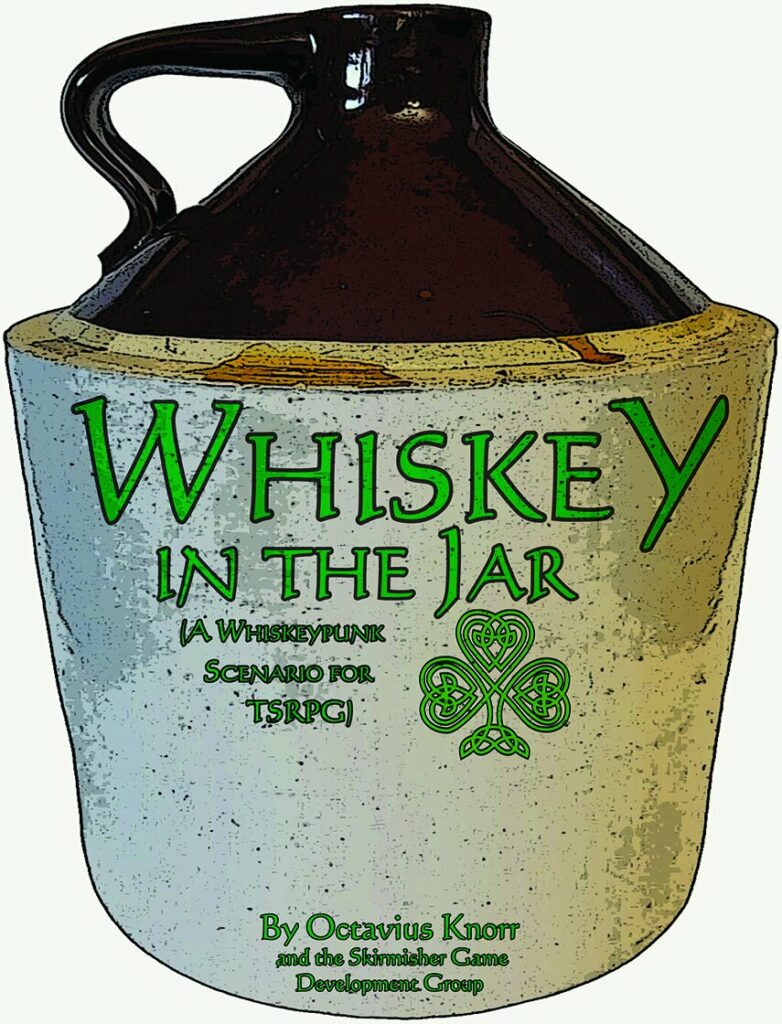
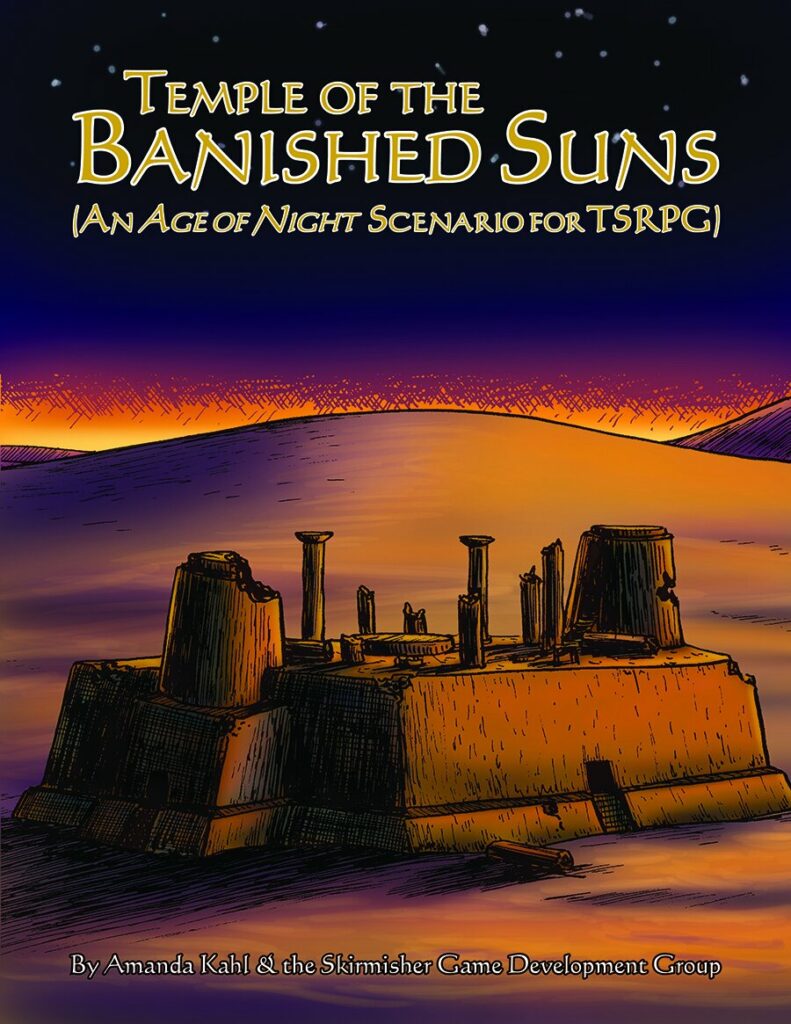
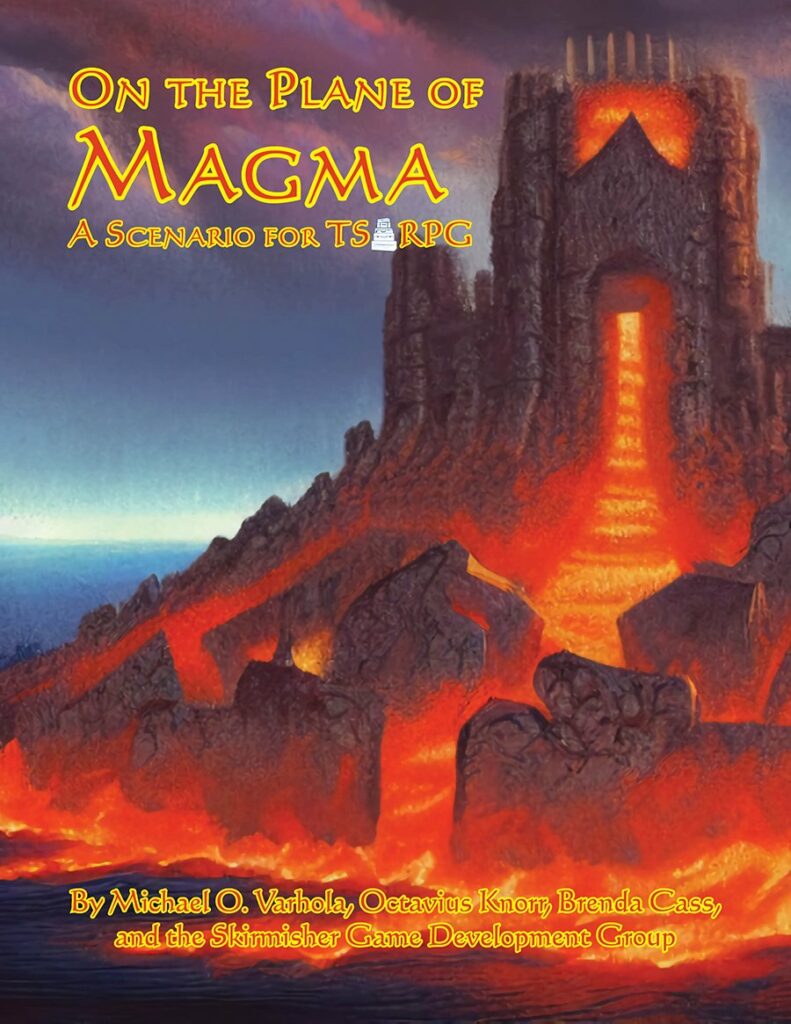
How do you balance the need for simplicity with the need for depth in TSRPG?
TSRPG offers a modular set of optional rules that can be used to add mechanical depth to the game. Optional rules don’t rely on each other, so that leaves players free to cherry pick specifically the ones that are relevant or fun for their scenario without having to worry about breaking the game. A lot of folks will miss the tactical depth of a more rules heavy game, and that’s okay, TSRPG wasn’t designed to scratch that itch. I think that for a lot of people, while TSRPG wouldn’t be their primary system (though I do know several folks in Germany that play TSRPG exclusively now), it could be the second system they learn and turn to because of the flexibility it offers.
What are some of your favorite scenarios for TSRPG?
“A Midsummer Night’s Scheme” because playing a Shakespearean fairy is a hysterically fun time, “Temple of the Banished Suns” because we got to finally do a crossover with fantasy artist and friend Amanda Kahl’s “Age of Night” comic series (and now she can’t claim she isn’t a game designer anymore).
What are some of the things you have learned from the feedback that you have received from players of TSRPG?
TSRPG almost wasn’t published, I didn’t think folks would be very interested in the quirky little game I wrote on a trip many years ago, but was I ever wrong. Folks have hacked TSRPG to run it GM-less, sent in translations of the game and its scenarios for three different languages, used it in classrooms to help teach English, and so many more things that I never expected. Players have definitely shown me how vast and creative the tabletop RPG community is.
What’s the most creative thing you’ve seen a player or GM do with TSRPG?
This expands a bit on one of my answers to the last question. The most amazing thing I’ve seen done with TSRPG is using it to teach English to kids affected by the war in Ukraine. The same group of volunteers has also translated it into Ukrainian, and Skirmisher has partnered with them to distribute copies of the rules for free to Ukrainian people that are interested in them.
You can find Brenda on Twitter. Skirmisher Publishing is a small press publisher of tabletop role-playing games. They are known for their innovative and creative games, such as the award-winning TSRPG. Skirmisher Publishing is committed to providing high-quality games that are both affordable and accessible to gamers of all levels. They also offer a variety of free resources for gamers, such as character generators, rulebook errata, and adventure modules.
Obsidian Portal Campaign of the Month April 2023: Torg Rise of the Storm Knights
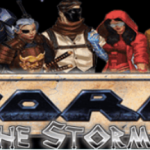
This month we enter the fascinating world of TORG, with the Savage Worlds system, where six brave adventurers cross worlds in their quest to defend the multiverse. GM Elvathadrin will take us through his game, Torg Rise of the Storm Knights and tell us a little about the process he has with his players to bring their stories to life.

First off, feel free to tell us about the person behind the GM screen. Where are you from? What do you do aside from gaming? Alter Egos? Life partners? Family? Where can we interact with you on the internet?
I am from New Jersey, lived here my whole life, don’t really have much of an online presence even though I am on the Obsidian Portal Discord. Outside of gaming, I enjoy hanging out with my friends watching movies. I also paint miniatures and when I can play miniature based games like Warhammer 40K and Xwing, I also play World of Warcraft, and Star Wars the Old Republic/this is the game I also RP most evenings in, and have for quite a few years.
Let’s talk about the visualization of your campaign. Did you make the animated banner yourself? And the video? What made you decide to place this video on your campaign’s landing page? Why did you decide to explain about your campaign in such a way? Are you the person speaking in the video?
The Banner was created by one of my good friends who’s also a player in my game. To be honest I found the video on YouTube, and why did I put it on the Landing page because after watching it I found it explained the universe of TORG perfectly, in an easy to understand and concise manner. I am not the person speaking in the video.
Is the narrator in the video meant to be the same person quoted in the description on the landing page?
The narrator in the video is not mean to be the same person quoted on the landing page, the man quoted on the page is an unknown individual that saw the initial events with his own eyes and lived the tell his tale.
I noticed that there was over a year’s time gap between your original start date in July 2021, and the next adventure entry in January 2023. What was the cause of this gap?
This is an easy question to answer, I started to work on the website a good year plus before the game we were playing ended, and I knew I had a lot of information I wanted to impart to my players, and knew it was going to take time to put it up and make it easy to read.
I see that you are using the Savage Worlds system. Can you please talk about what made you choose this system? How does the system support the campaign design and your game style?
I chose Savage Worlds because I was talking to a few of my friends about wanting to run a TORG game as I love the universe but not a fan of the system it uses, so they brought up Savage Worlds. The system in question is designed to be extremely malleable, and since TORG’s universe requires the ability to meld multiple of genres and make them fit with each other, Savage Worlds was perfect as it already did that so it made things easy to fit everything together without one overpowering the others. Savage Worlds had already put out different books that where all designed to work together from the beginning so it made it that much easier.
You seem to be integrating many characters from movies, tv, etc. Can you tell us a little about how you bring these characters to life? Do you study them from their respective franchises? Do you try to imitate their mannerism/voice?
Most of the characters I use are from TV shows and or games that I and most of my friends have already watched so they already know these characters, I do try to keep them in character and how they react and or help the group with their expertise in relationship to the universe itself.
At no point do I try to imitate their mannerisms or voices as I know I would never be able to do them justice.
How do the players contribute to the world design, if at all?
My players helped me with ideas for some of the new COSMS I have introduced into my universe that are not in base TORG, the ones they helped with where The Galactic Empire, The Big Heat, The Holy Roman Empire, Middle Westeros and The Main.
I see that you have a very detailed wiki section. How helpful is the Wiki for your players?
From what my players have told me it is extremely helpful, as it is referenced at least once most sessions, especially when they go into a new COSMs, the maps I created have also been extremely helpful to give my players an idea of where they are.
Can you please tell us why you choose to open each adventure log with a “wild cards” section which seems to include all the PCs? What is its meaning?
The reason I include the PC names is similar to the reason a TV show has credits, to remind the reader who the characters are in each session and if anyone new reads any Adventure log they know who was involved.
If you had to pick just one thing, what would you say Obsidian Portal helps you with the most?
Obsidian Portal helps with keeping all the information in one place and helps make it easy to find, if it wasn’t for the site I would never have been able to run this game.
What would you say is the biggest highlight of your game so far?
That is not the easiest of questions, but if I have to choose one, I would say the group was going after a Forest Dragon in Aysle the Fantasy COSM, the dragon preferred to hang out under water, so David the mad scientist of the group decided to create primitive depth charges. The idea was to drop them from the Quinjet.
While he was creating them, he created three by the way, the first and third where created without a hitch, unknown to anyone, David made a not so minor mistake on the second depth charge. When they went to use them, the first dropped fine and hit the water as it was supposed to, as they were getting ready to get the second in place the jostling caused it to explode prematurely while still inside the Quinjet, causing the jet to take a nose dive forcing Astoron to re-right the jet before it crashed, unfortunately he disconnected and completely froze forcing Ellistrae to quickly jump into action and right the jet. David the one that created the depth charge took the quick action to jump on the charge hoping to contain the blast, he succeeded in containing the blast not the concussive force that caused the jet to take a nose dive.
Okay, as a last question, we always ask for the GM’s “pearls of wisdom”. What GM insights can you offer the community this month?
I am still a fairly new GM, as I have only GMd four games, so most of my wisdom comes from that, I would say for those afraid to GM for the first time, don’t be afraid, because you will make mistakes, you will stumble as a GM, not everything you do is going to work, your players are going to throw monkey wrenches in your plans, from my experience, let them.. This is a collaborative effort, if your players come up with an off the wall idea, let them do it. It will make the game that much more fun and memorable.
Always remember you are the story teller, and it’s supposed to be fun for everyone, keep a light hand, don’t be heavy handed with your rulings.In the end as a GM always learn from your mistakes, because no matter how many games you run, you are still going to make them.
That’s all for this month folks! Don’t forget to head on over the the OP forums to nominate your favorite campaigns for our next Campaign of the Month!

